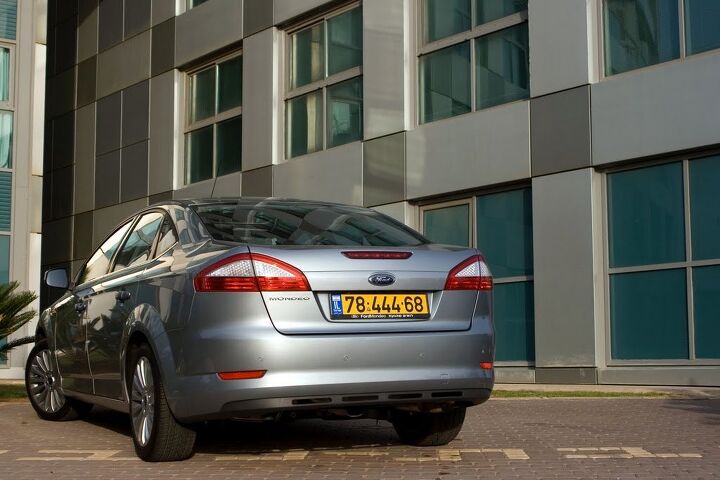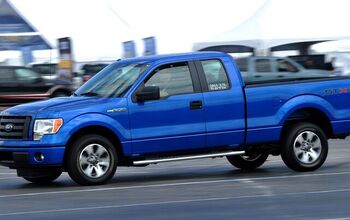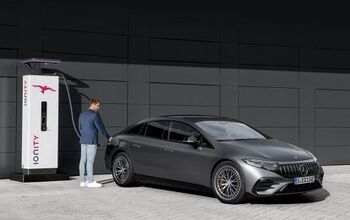Review: Ford Mondeo 2.3 Titanium
You can spell favorite both ways – the American way, with a single ‘o’ – and the British way, with a ‘u’ following suit. The Ford Fusion and Ford Mondeo are not unlike this fascinating grammatical phenomenon: they both come from the same manufacturer, and they both answer the equally strong demand for misize cars on both sides of the ocean – but they both differ in execution. Right?
Contour was gone after a few years of dawdling sales, never to return again.
But here we have the newest Ford Mondeo. Introduced in 2007 – and first driven by Agent 007 himself in Casino Royale, no less – it aimed at replacing the humdrum sedan which came before it with a bit more zest, and a lot more size.
While zest can be subjective, there’s definitely no arguing about the sheer size of the Mondeo. It’s no longer a compact-and-a-half – in fact, it trumps the Fusion in every exterior dimension, save for length – in which it’s exactly equal to the domestic sedan. At 112-and-something inches, its wheelbase brushes on the Mercedes E Class’s and its 74 inches of sheer width glance downwards on the S Class itself. Maybe these impressive figures shouldn’t come as a surprise seeing as the Mondeo shares its underpinnings with the Volvo S80.
Even with a quick glance from the outside, almost every inch of these impressive sheet-paper specs is apparent. The Mondeo looks massive, solid, and respectable – you can insert your own row of adjectives here. When it was introduced, Ford went to great lengths to emphasize the new “Kinetic Design Language” that was introduced along with it – see, you’re supposed to imagine the Mondeo moving, even when it’s stuck in harsh London traffic.
The thing is, kinetic design aside, this Euro-sedan ain’t pretty. The front is a good effort, what with its gently-chromed mesh grill (on the top of the line Titanium tester) and two swooping profile lines (say kinetic!) going all the way from the hood to the trunk. On their way over back there, however, something goes terribly wrong. The trunk is flat, looks glued-on and simply doesn’t harmonize with the rest of the car; if you stare long enough at the rear lights you’ll be able to see a kid’s sketch of a car with a huge side windshield. Kinetic windshield, so to speak. As if the complete lack of harmony between front and rear styling wasn’t enough, Ford has chosen to hide the twin exhausts under the cavernous body (why?), making up for that sin with a small diffuser with bullet holes in it.
As far as first impressions go, you’re better off starting with the interior, which manages to make up for the exterior’s disappointments. The build quality is good, and everything seems to be firmly secured in place – the doors are almost too heavy. More importantly, the cabin is a nice place to be – save for the slightly gloomy interior colors. Leather covers the seat bolsters as well as other critical areas and the softer kind of plastic is used generously throughout – and what’s not soft is generally good quality, unless you go touchin’ in hidden areas. The center console comes complete with a brushed aluminum finish which looks and feels good.
Most controls are simple and intuitive, with a logical layout and no excess of buttons. Due to the sheer width of the car, some of the controls – like the climate control panel – can be hard to reach if you’re of smaller proportions. The same goes for the gear lever which is a bit of a stretch for lazier arms. The touchscreen audio system you see in the photos is an aftermarket installation offered as an option by the dealer – the standard car comes with an original Sony stereo. Both are good sounding and easy to use.
There’s ample space in the cabin, too, thanks to the exterior dimensions. Shoulder room is especially impressive – both in the front and back. Four adults will feel comfortable in the Mondeo – both in terms of space and seat comfort. The front seats are, however, too wide for my size and don’t provide enough side bolstering. You can put the trunk on the ‘disappointing’ list as well. At 17.4 cubic feet, it isn’t exactly small – but it’s smaller than what you’d expect – especially while compared to the exterior – and not particularly easy to load due to a slightly raised floor.
My tester was equipped with a four cylinder 2.3 liter gas engine pumping out about 160 horsepower and a six-speed Durashift automatic. If the numbers add up to something familiar, it’s only because they should – the engine is courtesy of Mazda, having served its duty in the previous-generation Mazda3 and Mazda6. This is a large engine by European standards, judging by the Mondeo’s automatic gas-powered competitors which utilize 2.0 and smaller units – but then again, you have to remember this is the rarest Mondeo powertrain in diesel-loving Europe.
160 horsepower don’t sound like overwhelming power in a midsize sedan, and with a weight figure of more than 1.5 tons, it really isn’t. The Mondeo does the standard sprint to 60 in 10.5 seconds, but that’s only telling half the story, because despite the lack of power the engine and transmission combination works quite well, if a bit lacking in the sound department – provided you’re not hurrying anywhere, of course. Shifts are usually smooth, save for downshifts to first gear with manual control, and the engine donates whatever power it has to give in a fairly civilized manner.
The good news is that this engine is history, with the newly-facelifted Mondeo receiving a new 2.0 EcoBoost engine with 203 horsepower, without any cosmetic changes to the exterior. It will also receive Ford’s dual-clutch PowerShift gearbox. Which is just as well, as this Mondeo with a fresh 120 miles on the odometer, exhibited a not-too-impressive fuel consumption figure of just below 19 mpg during combined (if a little aggressive) driving.
It takes only a couple of minutes to realize that the Mondeo’s suspension is tuned to the softer side, and only a few seconds more to appreciate this. Ride quality is excellent with even rough roads failing to break the Mondeo out of its serenity, and yet the car never feels oversprung or floaty. Noticeable winds noises from the A pillar, which start at 70 mph, will be your primary cause for concern during a freeway cruise.
T
he previous Mondeo’s trump card was its balanced handling, so there was reasonable cause for worry that the many inches and pounds the new Mondeo gathered over the years will affect its athletic capabilities. The answer is twofold: yes, the new Mondeo feels heavier and a bit more disconnected than the previous generation, but it’s still a lot of fun to drive on twisting roads – almost more so than a car of its weight and caliber should.
The Mondeo grips the tarmac quite well and there’s even reasonable feel from the hydraulically-assisted steering. It resists understeer well, but driver provocations will quickly send the hyperactive electronic nanny berserk. The Achilles heels of the Mondeo’s dynamic abilities, like in some genuine American Fords, are the brakes. They border on average in strength, and the pedal feels too mushy and imprecise.
The name Mondeo is derived from the Latin word mundos, meaning world. The third generation Mondeo can finally carry this title in total peace of mind. The Ford Mondeo offers a complete package with a roomy interior, good cabin, excellent dynamic abilities and perhaps most importantly – that solid ‘big car’ feel, without the big car price.
It’s one car which could have been equally enjoyed by people on both sides of the pond, but instead Ford is waiting for the next-generation Mondeo to launch as a global car, like it recently did with the Focus. Judging by the quality of the effort on this sedan, I’d say they have a good chance of making it work.
Ford provided the vehicle, insurance and one tank of gas for this review
This review brought to you by icar.co.il
More by Tal Bronfer
Latest Car Reviews
Read moreLatest Product Reviews
Read moreRecent Comments
- Joe65688619 Under Ghosn they went through the same short-term bottom-line thinking that GM did in the 80s/90s, and they have not recovered say, to their heyday in the 50s and 60s in terms of market share and innovation. Poor design decisions (a CVT in their front-wheel drive "4-Door Sports Car", model overlap in a poorly performing segment (they never needed the Altima AND the Maxima...what they needed was one vehicle with different drivetrain, including hybrid, to compete with the Accord/Camry, and decontenting their vehicles: My 2012 QX56 (I know, not a Nissan, but the same holds for the Armada) had power rear windows in the cargo area that could vent, a glass hatch on the back door that could be opened separate from the whole liftgate (in such a tall vehicle, kinda essential if you have it in a garage and want to load the trunk without having to open the garage door to make room for the lift gate), a nice driver's side folding armrest, and a few other quality-of-life details absent from my 2018 QX80. In a competitive market this attention to detai is can be the differentiator that sell cars. Now they are caught in the middle of the market, competing more with Hyundai and Kia and selling discounted vehicles near the same price points, but losing money on them. They invested also invested a lot in niche platforms. The Leaf was one of the first full EVs, but never really evolved. They misjudged the market - luxury EVs are selling, small budget models not so much. Variable compression engines offering little in terms of real-world power or tech, let a lot of complexity that is leading to higher failure rates. Aside from the Z and GT-R (low volume models), not much forced induction (whether your a fan or not, look at what Honda did with the CR-V and Acura RDX - same chassis, slap a turbo on it, make it nicer inside, and now you can sell it as a semi-premium brand with higher markup). That said, I do believe they retain the technical and engineering capability to do far better. About time management realized they need to make smarter investments and understand their markets better.
- Kwik_Shift_Pro4X Off-road fluff on vehicles that should not be off road needs to die.
- Kwik_Shift_Pro4X Saw this posted on social media; “Just bought a 2023 Tundra with the 14" screen. Let my son borrow it for the afternoon, he connected his phone to listen to his iTunes.The next day my insurance company raised my rates and added my son to my policy. The email said that a private company showed that my son drove the vehicle. He already had his own vehicle that he was insuring.My insurance company demanded he give all his insurance info and some private info for proof. He declined for privacy reasons and my insurance cancelled my policy.These new vehicles with their tech are on condition that we give up our privacy to enter their world. It's not worth it people.”
- TheEndlessEnigma Poor planning here, dropping a Vinfast dealer in Pensacola FL is just not going to work. I love Pensacola and that part of the Gulf Coast, but that area is by no means an EV adoption demographic.
- Keith Most of the stanced VAGS with roof racks are nuisance drivers in my area. Very likely this one's been driven hard. And that silly roof rack is extra $'s, likely at full retail lol. Reminds me of the guys back in the late 20th century would put in their ads that the installed aftermarket stereo would be a negotiated extra. Were they going to go find and reinstall that old Delco if you didn't want the Kraco/Jenson set up they hacked in?








































Comments
Join the conversation
I don't understand why so many outlets refer to the Contour/Mondeo as failures. I don't remember them as such. I drove a 4 cylinder, automatic that my mother-in-law rented, and was actually wowed by the suspension tuning. Later, I bought a Toreador Red SVT contour with the blue leather seats, and what an animal that was. By today's standards, probably not so much, but in a rather light package, the 200hp, with the V-6 on cam, screaming really, the car was a hoot. I put nearly 100K trouble free miles on it, before moving to an SUV. I understand the criticism of the car's size, but again, that was back when everyone, much like today, felt they needed two tons of 7 passenger 4-wheel-drive surrounding them and shuttling their spouse and kid. By that measure, what car didn't come up short? On a more rational level, the Contour was a great car. A poor man's BMW if you will, especially in SVT digs.
Tal: I appreciate greatly the review. I just got done a comparo read in CAR with the Avensis Wagon and or the Mondeo wagon... How would you say they do in comparison? There is a really NICE shot of the two cars.. nose to nose, and the Knetic design has it over.. whatever Toyota is trying to pull over there. They look.. almost completely alike, small cuts and chisels in the design.. is the only visible differences. I did hear.. that while the Mondeo is a UK "product" it would "merge" with the Fusion for the U.S in the next generation. Nice to hear.